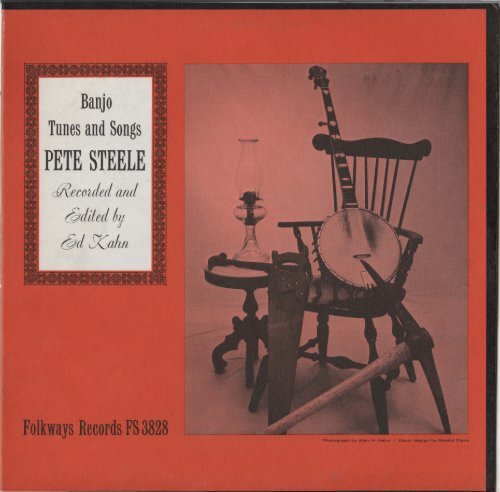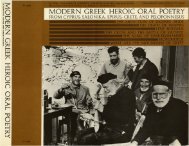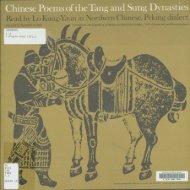PETE STEELE
PETE STEELE
PETE STEELE
You also want an ePaper? Increase the reach of your titles
YUMPU automatically turns print PDFs into web optimized ePapers that Google loves.
FOLKWAYS RECORDS Album No. FS 3828<br />
©1958 Folkways Records & Service Corp., 43 W. 61st St., NYC USA 10023<br />
Notes by Ed Kahn<br />
It was early in the summer of 1957 that I first met<br />
Pete Steele and his wife, Lillie. A friend of mine,<br />
Arthur Rosenbaum, and I decided to drive over to<br />
Hamilton, OhiO, and try our luck at finding them.<br />
We both knew that for the past number of years the<br />
Steele family had been living in Hamilton; however,<br />
no one seemed quite sure how to get in touch with<br />
them, and moreover, no one that we knew of had<br />
visited them recently. After a few phone calls, we<br />
were able to find the Steele residence, and in a<br />
short time Pete Steele was singing and playing for<br />
us.<br />
On this first occasion, Pete used my banjo because<br />
he had recently sold his in order to buy a pistol.<br />
He said that he hadn't played for several months,<br />
but in a matter of minutes he was playing the instrumentals<br />
that had won him fame through his<br />
Library of Congress recordings. On that visit, we<br />
recorded much of the material on a small home recorder.<br />
In the last part of August, I was able to visit him<br />
again. It is from this session that the material<br />
in this album is taken. Although he hadn't yet<br />
purchased a banjo for himself, he had played other<br />
banjos with some regularity since "Ule time of our<br />
first visit. The time spent with the Steele has<br />
afforded experiences that I shall never forget;<br />
ranging from the fine cooking of Mrs. Steele to the<br />
music that was so often being made.<br />
To the folklorist, Pete Steele is a very interesting<br />
informant. He represents a strong tradition of the<br />
Kentucky hills, in its various traditions. Wherever<br />
he lived or viSited, he picked up songs, molded them<br />
into his own style, and yet preserved the essence<br />
of the material that he learned.<br />
Throughout his life, music has served a very strong<br />
function, perhaps stronger with Steele than other<br />
folk musicians being studied today. Because of his<br />
lack of formal education, he has had to rely on<br />
materials other than the printed page for the<br />
sources of both his musical material and for his entertainment.<br />
Music has always been a major source of entertainment<br />
for Pete Steele. Whether he is singing<br />
harmony with his wife, entertaining friends, or<br />
playing a complicated banjo instrumental, he is<br />
aware of his ability to Sing songs "the old way"<br />
and play almost anything on his instrument. It is<br />
perhaps the amazing versatility that he has on the<br />
banjo that has given him the most pleasure, for,<br />
unlike many other folk musicians, Steele has a<br />
great versatility of styles and techniques on his<br />
instrument.<br />
While most folk instrumentalists generally use one<br />
style, Steele uses many, deciding for each song<br />
which style will be the most effective. The right<br />
hand technique most often employed by Pete Steele<br />
is a type of double thumbing with an occasional<br />
pinch of the first and fifth strings in order to<br />
add syncopation. This style is clearly heard on<br />
"Ellen Smith" and "Pretty Polly."<br />
In addition to this style, Pete Steele also use&<br />
a standard "up-pick" style. This can be heard on<br />
"Last Payday at Coal Creek." On many of 'the faster<br />
numbers he prefers frailing and "double noting" or<br />
double thumbing. This style is well illustrated<br />
by his renditions of "Shady Grove" and "Goin' Round<br />
this World, Baby Mine. "<br />
In all of these styles, Steele uses only his fore<br />
finger and thumb. To add to the versatility<br />
already achieved in his right hand, he uses as<br />
wide a variety of tunings as the individual songs<br />
may demand. The effects achieved are perhaps<br />
best shown in "Little Birdie" and "Train-Pullin'<br />
the Crooked Hill."<br />
Pete Steele was born in the small town of<br />
Woodbine, Kentucky, on March 5, 1891. It was<br />
in this area, frbm his father and people that<br />
he met, that he began to learn songs and the<br />
techniques of playing the five string banjo.<br />
" ••• at six years old, my father made a small<br />
banjo. He took a sieve and put a squirrel's<br />
hide on for the banjo head; put thread strings<br />
on it and that's how I learned to play a banjo.<br />
My father was a violin player ••• one of the<br />
best, I think ••• I learned most of my banjo<br />
pieces from him. We had lots of good times<br />
together playing music at the last days of<br />
schools and at box suppers and so on. And when<br />
I think of those good times we had together,<br />
I get to feeling very sad, wishing we could be<br />
together and live them days over •••• "<br />
At the age of nineteen, Mr. Steele married<br />
Lillie Swanner. Miss Swanner was born in<br />
Pittsburg, Kentucky, but at the age of six<br />
her family moved to London, Kentucky, where<br />
her father bought a farm. Of London, she<br />
remembers: " ••• I worked with my father in<br />
the fields as my brothers were much younger<br />
and not yet old enough to work. At the age<br />
of sixteen I got married ••• :'<br />
After their marriage, they lived in various<br />
parts of Kentucky, Indiana, and Ohio, where<br />
Mr. Steele worked at jobs ranging from<br />
carpentering to making staves for whiskey<br />
barrels, and back to farming, his original<br />
occupation. Probably the most formative years<br />
for the Steeles, from a folk music point of<br />
view, were the eighteen years they spent in<br />
Harlan County where Pete worked in various<br />
coal mines. From Harlan County, they moved<br />
to Indianapolis, Indiana, for a few years,<br />
and then back to Laurel County, Kentucky, where<br />
both Pete and Lillie Steele had spent their<br />
childhoods. Of East Bernstadt, in Laurel County,<br />
Pete remembers: " ••• there I played my banjo<br />
for our neighbors to square dance. We would<br />
all meet at one neighbor house one Saturday<br />
night and the next Saturday night at another<br />
house .••• II<br />
After leaving East Bernstadt, they moved to<br />
Hamilton, OhiO, where they have lived since<br />
1937. In 1938 Alan Lomax recorded the Steeles<br />
for the Library of Congress Folk Music Archives.
Although more than. thirty recordings were made,<br />
only a few of these have been made available<br />
to the public through records issued by the<br />
Library.<br />
The purpose of this album is to make generally<br />
available same of the more than two score songs<br />
that they have been singing in their family for<br />
years, and :fUrthermore, to offer comparative<br />
material for those interested in studying the<br />
musical tradition of one family over many years.<br />
In the following notes, I have indicated Library<br />
of Congress archive numbers for those songs that<br />
are depesi ted in the Library.<br />
NOTES ON THE SONGS ---------<br />
SIDE I, Band 1: ELLEN SKITH<br />
------<br />
In 1893 Peter De Graff was convicted of the murder<br />
of Ellen Smith. As a result, several local<br />
murder ballads gained currency. Today, there are<br />
two slightly different ballads of Ellen Smith.<br />
In one, the narrator admits killing her, and in<br />
the other pleads that he has been accused of a<br />
crime which he did not commit. Steele introduces<br />
his version by saying: "The song of 'Ellen Smith, '<br />
and it was a boy that took the punishment of<br />
some other man's crime." The tune closely<br />
resembles the religious song "How Firm a Foundation. "<br />
Steele learned this version from Andy Whitaker, of·<br />
Shelbyville, Kentucky. I was unable to locate<br />
Mr. Whitaker or find anyone who knew of him or his<br />
family.<br />
References:<br />
Brown II, pp. 714-717<br />
Brown IV, pp. 326-327<br />
Combs, pp. 219-222<br />
Fuson, p. 132<br />
Laws NAB, pp. 190-191<br />
Richardson, pp. 32-33<br />
MFS, 1707 B<br />
"Ellen Smith"<br />
Oh, it's poor Ellen Smith<br />
This poor girl she was found<br />
With a ball through her heart,<br />
Lying cold upon the ground.<br />
I was saw on Friday,<br />
Before that sad day,<br />
They picked up her cold body<br />
And carried hit away.<br />
Oh, they gathered their Winchesters,<br />
They chased me all around,<br />
They found this poor boy<br />
In the :fUr edge of town.<br />
Oh, they send me to Frank:fUrt<br />
I've been there before,<br />
I wore the ball and chain<br />
Till it made m:r ankles sore.<br />
I courted her through years<br />
For to make her m:r wife,<br />
I loved her too dearly<br />
To take her precious life.<br />
Some day before long<br />
We'll stand before the bars,<br />
And when God tries our case,<br />
We'll shine like a star.<br />
SIDE I, Band 2: LITl'LE BIRDIE ------<br />
Lyric songs of the folk singer have often<br />
centered about the carefree life of the little<br />
bird. In "Little Birdie," a lonesome person<br />
longs for the advantages of the little bird's<br />
life. Although I have heard this song sung<br />
many times, the only printed text which I can<br />
find is in Randolph (I, pp. 121-122). His<br />
text, under the title "The Dark Hollow," has<br />
three stanzas which bear a close resemblance<br />
to "Little Birdie" as I have heard it sung.<br />
Steele's version, while maintaining essentially<br />
the same tune which Randolph gives, differs<br />
textually from the printed version. Steele<br />
learned this version from Jesse Herald of<br />
Kentucky.<br />
References:<br />
Randolph, I, pp. 121-122<br />
MFS, 1694 Al<br />
"Little Birdie"<br />
Little birdie, little birdie,<br />
Come sing your song to lIIej<br />
For I am so lonesome,<br />
Lonesome as can be.<br />
Pretty birdie, pretty birdie,<br />
What makes you :fly so high?<br />
You must have another true love<br />
Far up in the blue sky.<br />
Wish I was a little birdie,<br />
I'd not build m:r nest in the air,<br />
Build m:r nest in m:r true love's breast,<br />
And steal the locks of her hair.<br />
There's a place called heaven, boys,<br />
A place where them angels dwellj<br />
There's a place of paradise,<br />
But there's no place like Hell.<br />
SIDE I, Band 3: THE TRAIN A-PULLIN'<br />
THE CROOKED HILL<br />
Banjo players have long loved to immi tate the<br />
sounds of life around them. The train has been<br />
an extremely popular starting point for many of<br />
these instrumentals. Steele learned this complicated<br />
instrumental from Andy Whitaker. He<br />
tunes his banjo to DCGCE, from first to fifth<br />
string.<br />
Reference:<br />
MFS, 1704 B2<br />
SIDE I, Band 4: INTERVIEW AND RELIGIOUS SONGS<br />
Folk belief has long had it that the banjo, as<br />
well as other stringed instruments, is the<br />
devil's ins trument (see Brown I, p. 97). Pete<br />
Steele's answer to the question concerning the<br />
banjo as the devil's instrument represents a<br />
general easing of former restrictions placed on<br />
"religious" people. Steele considers religion<br />
and the music of stringed instruments to be completely<br />
compatible. The Steeles' singing of<br />
religious material also shows a family tradition<br />
that they still enjoy.




